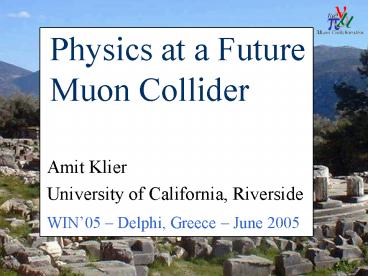Physics at a Future Muon Collider PowerPoint PPT Presentation
Title: Physics at a Future Muon Collider
1
Physics at a FutureMuon Collider
- Amit Klier
- University of California, Riverside
- WIN05 Delphi, Greece June 2005
2
OUTLINE
- Why muon colliders?
- Advantages
- Problems
- Some physics
- Light Higgs Factory
- Heavy Higgs
- Toward a muon collider
- Recent advances in 6-D Cooling RD
3
Why Muons?
- As fundamental as electrons
- Unlike p, p, all the collision energy is useful
- and 200 times as heavy
- Sync. radiation energy loss is 2 billion times
less - Compact storage rings up to a few TeV
- Very good energy resolution
- Coupling to the Higgs boson is 40,000 times
greater - Produce Higgs Bosons via the s-channel
4
Muon Colliders, Other Machines
5
The Problem with Muons
- They DECAY muon lifetime 2.2 ms
- Everything has to be fast, specifically
- Cooling (ionization)
- Acceleration (RLA, FFAG)
- Muon Collider detectors need shielding against
gs from decay electrons - Decay neutrinos can be harmful at Emm?4 TeV
- (they can be useful for a Neutrino Factory, but
thats for another talk)
6
Some Physics
7
Light Higgs Boson
- Precision EW data seem to favor light SM Higgs
Boson - So does SUSY
- (from theory)
8
SM (or SM-like) Higgs Factory
- Higgs Boson width few MeV for mhSMlt160 GeV
- Fine scan for DE ? G hSM
- Use spin precession for in situ energy
determination to 1 ppm - Luminosity is compromised by resolution, e.g.
- R0.003 Lyear 0.1 fb-1
- R0.01 Lyear 0.22 fb-1
- R0.1 Lyear 1.0 fb-1
- ( R2DE/E )
9
Precision Measurements
- For a SM-like 110-GeV Higgs Boson, a muon
collider Higgs Factory can measure the mass to an
uncertainty of 10-6 with L0.2 fb-1 (compared to
10-4 at a 500 GeV, 500 fb-1 LC and 10-3 at the
LHC) - Only in the s-channel Gh can be measured directly
(otherwise need accurate WW rate measurement,
difficult at mhlt120 GeV) - Precise measurement of the cross section of
mm-?h0?bb independent of mb
10
Heavy Higgs Bosons
- SUSY H0 and A0 may be observed at the LHC
- Light h0 indicate high tanb, which implies
greater H0-A0 mass degeneracy - Muon g-2 results also favor high tanb values
(?8), with similar consequences - An intermediate energy (few hundred GeV) muon
collider can be used to scan the the heavy Higgs
mass range separate the two
11
Separating the Heavy Higgses
12
Another Scenario
- For some values of tanb (8-10) and mA (?250 GeV)
LHC/LC may not be able to observe H0 or A0 - A muon collider may be needed to discover the
heavy Higgs in this region
13
CP Violation in the Higgs Sector
- Polarized muon beams can be used to measure CP
violation in the Higgs sector
14
RD Advances
15
Toward a Muon Collider
- The physics part of this talk is mostly based on
Snowmass 2001 (and earlier) results. Thats old
news - Muon Collaboration attention has shifted to the
(seemingly more feasible, and probably as
important) neutrino factory - This shouldnt have affected the Muon Collider
RD effort - Indeed, impressive advances were made, especially
in simulating 6-D cooling
16
How To Build a Muon Collider
?
p
? ? ?
?-
target
proton driver (a few MW)
proton linac
pion decay
muon cooling
muon acceleration (up to 0.1 - 3 TeV)
storage ring
detector
17
How Much Cooling is Needed
Light Higgs Factory
Beam reduction of about ?100 needed in each
transverse and in the longitudinal direction
(106 6-D cooling) compared with muons from pion
decay
18
6-D Cooling
absorber
absorber
- Ionization cooling
- Fast, but cools only in
- transverse directions
- (sufficient for n factory)
- 6-D cooling via emittance exchange
- Repeated cooling/
- emittance exchange
- cools m beam in all six
- phase-space dimensions
RF
RF
?
large angular spread
small angular spread
19
Ring Coolers
- First suggested by V.Balbekov in 2001
- 6-D cooling about ?50
- However
- Problems trying to introduce realistic magnetic
fields - Injection/extraction very difficult and affects
performance badly
20
The RFOFO Ring
- Suggested by R.Palmer in 2002
- 6-D cooling ?300
- Simulations work with realistic magnetic field
- Injection/extraction still a problem, but
performance is less affected (still cools by
about ?200)
21
Gas-Filled Cooling Ring
- The idea use the dipole volume itself as a
wedge absorber by filling it with high-pressure
H2 gas - Small Dipole Ring suggested by A.Garren, H.Kirk
in 2004 - Can be used to demonstrate 6D cooling
experimentally moderate performance, but low
cost (no SC)
1.6 m
22
Further Cooling Lithium Lens
- Recently simulated transverse cooling down to
0.3 mm - But longitudinal emittance blows up
- Latest development use bent Lithium Lenses ( Li
ring)
23
Helical Cooling Channel
- Suggested by Y.Derbenev/Muons Inc.
- High-pressure-H2-filled helical dipole RF
cavities in a solenoid - Simulated cooling ?300
- Advantage no need for injection/kicker
- Challenges high dipole fields, rather complicated
24
Parametric Resonance Cooling
- Suggested by Y.Derbenev Muons Inc.
- Potential cooling ?10 after the HCC/ Ring Cooler
25
Reversed Emittance Exchange
- For TeV-scale muon colliders, longitudinal
cooling is sufficient, but more transverse
cooling is needed - Reverse the emittance exchange process
26
Conclusions
- Muon colliders can contribute to Higgs physics in
unique ways, complement LHC/LC - Being compact, muon colliders may eventually cost
less than the conventional ones (LHC/LC), but
are extremely challenging - A lot of progress in 6-D cooling simulations
- Greater effort is needed to put everything
together, demonstrate 6-D cooling in real life

